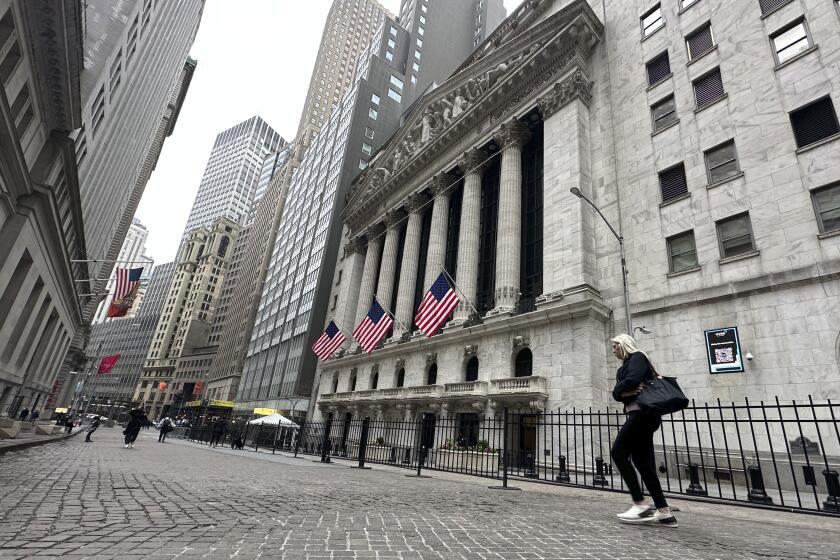Leaving North Las Vegas no option for many ‘underwater’ homeowners
Charles Mills can barely afford to stay here. But he also can’t afford to move.
That’s why the 44-year-old heavy-equipment operator was preparing to leave his wife and young daughter here and go where he could find work — the Oklahoma oil fields. Mills has a mortgage to pay, even if its size pains him.
He purchased his house in 2006 for $308,500. Current value: $105,797.
“We talked about it: What can we do with the house?” Mills said. “Nobody’s going to buy it. Nobody’s going to rent it. If we walk away, my credit’s shot. We’re stuck.”
In some parts of North Las Vegas, more than 80% of homeowners have plunged “underwater,” meaning they owe more on their mortgages than their properties are worth — a stunning concentration of aborted plans and upended lives.
Mobility in search of new opportunity has long been a cornerstone of the American economy, much the way homeownership has long offered a path to firmer financial footing. But the housing bust has left tens of thousands of homeowners across Nevada essentially trapped.
They’re considered the new normal here. They turn down higher-paying jobs elsewhere because they can’t move. They tidy the yards of houses left vacant by foreclosure. They realize it’s unlikely their children will receive tidy inheritances from the sale of their suburban homes.
When they look about their neighborhood, they question things they never questioned before. Are dead plants a sign that someone forgot to water? Or did the water get turned off? Does a garage sale mean more neighbors are about to bail?
“We don’t even walk around our own neighborhood anymore,” Mills said. “Why? To say hi to strangers?”
Elsewhere on Midnight Breeze Street are Steve and Gay Shoaff, who once talked of selling their house and retiring somewhere pretty. Gay, 57, even toured a place in Wyoming.
But the Shoaffs have been living mostly off savings since the construction industry sputtered. Steve, 60, worked as a drywall taper and foreman.
“I’d say, ‘Gay, we’re going to become millionaires on this house,’ ” Steve recalled one day as he and his wife unwound in the backyard they’d spent thousands of dollars sprucing up. Gay mustered a smile.
Their $187,980 home is now assessed at $99,220.
“This house won’t be worth what we paid on it until after we die,” she said.
Some economists would agree, predicting that a full recovery in parts of the West’s “foreclosure belt” — California, Nevada and Arizona — won’t occur until at least 2030.
Nationwide, 23.1% of homeowners with mortgages are underwater. No state is more underwater than arid Nevada, with about two-thirds of borrowers holding such mortgages, according to CoreLogic, a Santa Ana research firm.
Some economists argue that, in a way, these homeowners are worse off financially than those who lost their houses through foreclosure and were forced to move on. Those borrowers often were able to live rent-free for years because of the snail’s pace of foreclosure proceedings.
Meanwhile, their underwater neighbors poured money into mortgages, not savings or investments. They couldn’t chase higher-paying work. Homeowners with negative equity are at least a third less mobile than other homeowners, according to a recent study in the Journal of Urban Economics.
But abandoning their homes was an option that appeared too dicey. “Walking away, it does wreck your credit history for a while and you can’t get another mortgage for seven years,” said Richard Green, director of the USC Lusk Center for Real Estate. Defaulting also makes it harder to rent an apartment. “The other thing is, there is also some sense of obligation to repay your bills,” he said.
Indeed, some North Las Vegas residents would rather forge a community here. Some feel blessed to have held on to their homes when so many people lost theirs.
The Shoaffs purchased their house in 2004 so Steve could shorten his commute to jobs on the Las Vegas Strip. Home buying was so frenzied that, to snatch up the property at a model home, Gay had to shoo away an investor who tried to push her out of line.
They plowed money into a shaded patio, a neatly kept yard and other renovations. Financially, it made sense: There was so much building that Steve could work up to 100 hours a week.
Home to Nellis Air Force Base and more than 200,000 residents, North Las Vegas arrived late to the home-building frenzy.
“It had a historical reputation as working class, blue collar, and some may have viewed it as a high-crime type of an area,” said John Restrepo, who runs an economic consulting firm in Las Vegas. Developers snubbed it — until more desirable land grew scarce.
When the Shoaffs arrived after selling another home, neighborhoods were sprouting so quickly that services struggled to catch up. Trash pickups were infrequent. For a time, there was no home mail delivery. Their ZIP code kept changing.
Still, they planned to stick around to see the desert transformed. The nearby streets of Slow Breeze and Tropic Breeze were filling up. The University of Nevada, Las Vegas, planned a satellite campus. There was talk of building a shopping center to rival Minnesota’s Mall of America.
“We grew up with the mentality that you buy your house and stay in it for a while,” Steve said. “You don’t buy and sell and buy and sell.”
But as the recession pummeled Nevada’s tourism and construction industries, the promise of North Las Vegas collapsed as spectacularly as its home prices. Plans for the satellite campus and mall crumbled. So did the Shoaffs’ dreams of a retirement home.
Mills, who was lured here from Los Banos, Calif., in 2006 by good-paying work and cheap housing, started seeing more neighbors padding around during the day, suggesting they had lost their jobs. Suddenly, they would vanish — sometimes after ripping out their toilets and sinks.
A family who lived near Mills, whose little boy played with his daughter, recently moved after his secretary mom and construction worker dad were laid off.
“I told my wife we don’t have friends anymore. They all move away,” he said.
Mills’ wife, Maria, was let go by the entertainment department of a casino. He bounced from job to job, sometimes trucking cooking oil around Utah and Nevada, sometimes juggling security and janitorial work.
Determined to hang on to their four-bedroom house, he and his wife returned two new Nissans. “The cars, those are toys. Those are material things,” Mills said. “This is home.”
They waded through a mound of paperwork — and instructions to temporarily stop paying their mortgage — to cut their $1,600 monthly payment to about $900. The total amount they owe, however, remains the same.
James R. Follain, a senior fellow at the State University of New York’s Rockefeller Institute of Government, argued in a recent study that former home-building hot spots, such as Las Vegas and California’s Inland Empire, may crumble in the manner of Rust Belt manufacturing towns.
“There is a different mechanism leading to a similar outcome,” Follain said. “It was built on this upbeat set of assumptions about the future of house price growth, of population growth.”
So last month, while Mills was gearing up for Oklahoma, the Shoaffs tried to keep their neighborhood from looking like so many in the Las Vegas Valley, the ones marred by one decaying home after another.
Drive down Midnight Breeze, and you’ll spot few obvious signs of the real estate bust: no bank-owned signs, no broken windows, no doors jammed with unclaimed pizza fliers. That’s partly because Gay busies herself yanking weeds from yards and ripping foreclosure notices from garage doors so the vacant homes won’t tempt vandals.
On a recent evening, however, the Shoaffs took a walk through the neighborhood. In a backyard a few blocks away, someone had shoved over a foosball table, smashed a computer, tossed around stuffed animals and ruined the hot tub with what appeared to be white paint.
Gay’s face fell. This house was likely another foreclosure casualty, its owner long gone.
The Shoaffs aren’t going anywhere.
Times photographer Gina Ferazzi contributed to this report. Powers reported from North Las Vegas, and Lazo from Los Angeles.






